Cato Uniting (Methodist) Church
(now Uniting Church Archives), Orrong Road, Elsternwick
B 1870 Merklin-Schutze, Brussels & Paris for St John's Anglican Church, Toorak;
inst 1914 Methodist Church, Elsternwick Geo Fincham & Son;
reb 1919 Meadway & Slatterie (tubular-pneumatic action, new console);
inst 1923 new church; reb 1926 George Fincham & Sons.
3 manuals, 29 speaking stops, 5 couplers, tubular-pneumatic
Rem. 2003 Wakeley Pipe Organs and placed in storage
MERKLIN-SCHÜTZE ORGAN
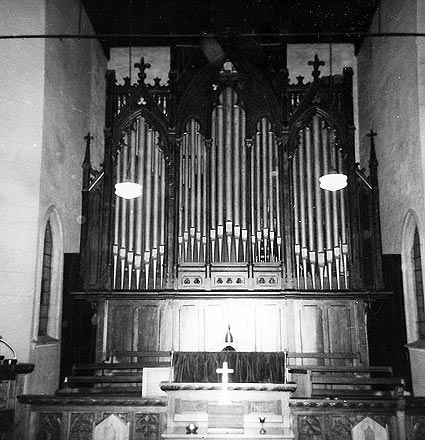
Historical and Technical Documentation by John Maidment
© OHTA, 2008, 2012 (last updated April 2012)
The three-manual organ formerly at Cato Uniting Church, Elsternwick was built in 1870 by the Brussels firm of Merklin-Schütze.[1] Imported by the Melbourne musical entrepreneur George L. Allen[2], it was apparently destined for “Melbourne Cathédrale” according to the firm’s records.[3] Melbourne Cathédrale would have been St Patrick’s Catholic Cathedral, the nave of which was opened in 1868. The Merklin-Schütze organ was a large French-romantic style instrument of three manuals and 28 speaking stops, with an outstanding neo-Gothic case in grained oak, and a reed chorus on the Grand Orgue at 16, 8 and 4 foot pitches that would have sounded splendid in the resonant acoustics of the cathedral’s nave.
The organ was built utilising Merklin’s patent (Brevet d’Invention) of 27 August 1868[4] that allowed for the mechanical borrowing of stops between keyboards and pedals by purely mechanical means. This involved the use of duplicate wind channels, sliders and pallets in the windchest. By these means, an additional eight stops were provided on the Positif (later termed Choir Organ) and three Pedal stops were provided from the manuals. This was a very avant-garde mechanical feature at the time and could not be seen in any other Australian organ of the period.
However, the instrument was not to be placed in St Patrick’s Cathedral, where there was a small pipe organ of English origin. The Argus of 13 September 1870 recorded that an organ “of Belgian manufacture by Merklin-Schütze of Brussels, which will have three-manuals and will embrace every variety of modern improvement. The organ will possess such combination of stops as hitherto have been unknown in this country … This will be the first Belgian organ imported into the colony”.[5]
A contemporary description of the organ was published in 1872:
A trial of the new organ at St. John's Church, Toorak, took place on Saturday afternoon before a numerous assemblage of ladies and gentlemen. The players were Signor Giorza, Mr. L.L. Lewis (the honorary organist of St. John's), and Mr. J. Edwards, organist at All Saints', St Kilda. The instrument comes from the house of Merklin-Schutze, of Brussels and Paris, and was imported to order by the firm of Wilkie, Webster, and Allen, of this city. It has been erected by Mr. Renton (from Hill and Son's), who manages the organ department of the importers' business. We subjoin a description of the instrument, which has three manuals : - Great organ, CC to G, 56 notes; in this the wood pipes are 16ft. bourdon, 56 pipes, 8ft. bourdon 56, and 8ft. flute 56 pipes. The following are all metal, with 56 pipes in each rank, except the voix celeste, which has only 44, namely – open diapason 8ft., salcional 8ft., flute harmonique 4ft., mixtures 3 ranks. The following are reeds, namely – Trompette harmonique 8ft., cornopean 16ft., and clarion 4ft. "Choir organ" – this is borrowed from "the great," and is made up from the harmonic flute, bourdon, salcional, voix celeste, doublette (two rows out of the three ranks of mixtures), and trompette. Swell organ – This contains bourdon 8ft. wood, and tin gamba 8ft., harmonic flute 8ft., echo-flute 4ft.; and "reeds" as follows:- namely, trompette 8ft., bassoon hautbois 8ft., and voix humaine (solo stop) 8ft. Each of these ranks contains 56 pipes. Total 25 stops, and 1,108 pipes. The pedal organ ranges from CCC to D, 27 notes, and is also borrowed from the great, and consists of bourdon, open diapason and cornopean. The couplers are from great to pedal, choir to pedal, swell to pedal, swell to great, swell to choir, tremulant and expression stops, and combination stops for the management of the "reeds" in the great and swell organs. The bright polish of the tin pipes gives the front of the instrument a very silvery appearance; but this is not noticed, as the organ is not visible from the body of the church, neither is the organist, who sits at the side of the instrument, and has full view of the choir. The dimensions of this instrument are 27ft. high, by a width of 16ft., and a depth of 7ft. 4 in. It is of easy touch and the "borrowing system" observable throughout its construction saves the making of separate sets of pipes. The same pipe speaks at the same moment on the choir and great, so that a solo can be played on the choir and accompanied on the "great" by means of a double set of palettes. The vox humana and the voix celeste are reed stops of singular beauty of tone. The effect of the invisible organ in the church is very pleasing, and the general character of ist tone is distinguished by sweetness rather than power, which for a church the size of St John's, Toorak, is highly to be commended. The organ is to be formally opened on Sunday 24th November.[6]
The organ appears to have been placed in a chapel to the south of the chancel, speaking into the building through low arches. This area was later refurbished by architect Louis R. Williams and is known colloquially as the Angel Chapel.
It is possible to deduce what the specification would have been from an internal examination of the pipework and windchests, together with the press description above (which cannot be entirely accurate) and reference to the contemporary Merklin-Schütze organ in Liège Cathedral, Belgium.[7]
| GRAND ORGUE Bourdon Montre Flûte Harmonique Bourdon Salicional Voix Céleste TC Prestant Fourniture Basson Trompette Harmonique Clairon Réunion du Récit à Grand Orgue RÉCIT Flûte Harmonique Bourdon Viola di Gamba Flûte-écho Trompette Basson-Hautbois Voix Humaine Tremblant POSITIF [derived from G.O.] Flûte Harmonique Bourdon Salicional Voix Céleste Prestant Quinte Doublette Trompette Harmonique PÉDALIER [derived from G.O.] Sousbasse Flûte Basson Réunion du Grand Orgue au Pédalier Réunion du Récit au Pédalier Réunion du Positif au Pédalier |
16p 8p 8p 8p 8p 8p 4p 3p 16p 8p 4p 8p 8p 8p 4p 8p 8p 8p 8p 8p 8p 8p 4p 2-2/3p 2p 8p 16p 8p 16p |
[3 rangs] |
Introduction des Jeux de Combinaisons du Grand Orgue
Introduction des Jeux de Combinaisons du Récit
Réunion Grand Orgue sur Machine
Expression (lever swell pedal operating vertical shutters)
Compass: 56/30
Console attached on right hand side of organ
Mechanical key and stop action
Barker lever pneumatic assistance to the Grand Orgue
In March 1877 George Fincham took over the tuning and maintenance. He wrote to the organist L.L. Lewis in March 1877: “The work I propose doing for the sum named (£18) is to clean and cover with metal shades the Great Organ reeds[8] and to equalize same. To lengthen the Pedal Open Diapason[9] and make the most it is possible of them. Also to make two new pipes to take the place of those pointed out – these two pipes have been cut up too much in the voicing and have been pasted over mouths to lower same to proper position. There are many other pipes in the organ that have been treated in a like manner but more successfully of course these I will not meddle with.”[10]
In a letter dated 27 January 1898 to the Vicar of St John’s. the Revd W. Fellows, Fincham wrote: “I have been requested to estimate for new Open Diapason in place of Montre,[11] new Trumpet in place of present one,[12] and Principal in place of Flute Harmonic.[13] Also a new Tremulant. I wish to point out that this is a favourable opportunity to make the Pedal soundboard sound, repair the Pedal Open Diapason[14] and recentre the blowing action. I have estimated the whole of the work closely and can do all the above work for the sum of £80.[15]
In July 1905 refurbishment of the organ was being considered by St John’s Church.[16] In October 1905, George Fincham & Son wrote to Colin Templeton, 31 Queen Street, Melbourne. The scheme of alterations included a new Great Open Diapason 8 foot 56 pipes, Great Principal 4 foot 56 pipes and Swell Gemshorn 4 foot 56 pipes, all in spotted metal, together with 9 composition pedals. Also, the “rearrangement and proper grouping of the whole drawstop action, the knobs to be placed in proper position, also the supply of new knobs throughout. Removal of keyboards, pedal board, etc from present position to the Northern side of the organ (where the show front pipes are).”[17] Mercifully, none of this work took place.
A new organ was installed at St John’s Anglican Church in 1913, built by Hill & Son, London as the firm’s job number 2432. This was placed in a new purpose-built chamber on the northern side of the chancel. The Merklin-Schütze organ had been placed in a chamber to the south of the chancel (now the Angel Chapel) where it must have occupied the whole space, with minimal tonal egress. It remained at St John’s until 1914 when it was sold to the Methodist Church, Orrong Road, Elsternwick.
On 7 May 1914 an estimate of £50 from George Fincham & Son was supplied to Fredk K. Levens, from the Elsternwick church, “to take down and re-erect above instrument in your church.”[18] This quotation was accepted on 10 June 1914. During the dismantling of the organ, at least three of the oval shaped porcelain plaques that indicated the functions of the various toe pedals were buried in the St John’s churchyard, only to be resurrected in the 1990s.
The organ was initially erected in the original Elsternwick church building, at the southern end of the site, and presumably remained unaltered mechanically. In 1919 the instrument was rebuilt by Meadway & Slatterie, a Melbourne organbuilding firm based in Crossley Street in the city.[19] This work involved the removal of all the original Merklin-Schütze actions and console of 1870 and replacement with exhaust tubular-pneumatic action, a new double-rise reservoir as a breakdown for the electrical blower, the conversion of the barker lever reservoir to a swell reservoir, and the introduction of a detached three-manual console with endolithic drawstop heads and anglicised stop names; the original oak Merklin-Schütze bench survived.[20] In 1923 it was re-erected in a large and spacious chamber at the present red brick Elsternwick church. This work appears to have been very unsatisfactory as a full overhaul was carried out in 1926 by George Fincham & Sons Pty Ltd at a cost of £258, quite a substantial sum for a renovation.[21]
The tubular-pneumatic action became increasingly unplayable and maintenance work was carried out in the 1950s by George Fincham & Sons Pty Ltd without effecting any significant improvement. By the mid 1960s the organ was becoming increasingly unplayable (a sound recording exists from 1966) and by 1978 its use and maintenance had been discontinued owing to the failure of the 1919 actions.
The instrument was dismantled in 2003 by Wakeley Pipe Organs Pty Ltd and initially placed in storage in Fitzroy, but the parts have since been moved to Kilsyth.
The specification of the organ, noted in 1966, was:
| GREAT ORGAN Bourdon Open Diapason Stopped Diapason Flute Salicional Voix Celeste TC Principal Mixture 12.15.19 Double Trumpet Harmonic Trumpet Clarion Swell to Great SWELL ORGAN Stopped Diapason Gamba Harmonic Flute Gemshorn Cornopean Bassoon-Oboe Vox Humana Tremulant CHOIR ORGAN Stopped Diapason Harmonic Flute Salicional Voix Celeste TC Principal Fifteenth Trumpet Swell to Choir PEDAL ORGAN Open Diapason Bourdon Bass Flute Trombone Great to Pedal Swell to Pedal Choir to Pedal |
16 8 8 8 8 8 4 III 16 8 4 8 8 8 4 8 8 8 8 8 8 8 4 2 8 16 16 8 16 |
A C D (borrowed from Great) from C wd A B D |
Compass: 56/30
Tubular Pneumatic action
Detached drawstop console
3 thumb pistons to Great
3 thumb pistons to Swell
3 composition pedals to Great
3 composition pedals to Swell
Balanced mechanical swell pedal
What is significant?
The pipework, surviving Gothic casework, two slider windchests, two reservoirs, building frame and swell box that survive from the 1870 organ.
This was the largest European organ to be exported to Australia in the 19th century – the only serious contender being the 1871 organ at St Kilian’s Catholic Church, Bendigo built by R.A. Randebrock, Paderborn, Germany.
This was the earliest major example in Australia of a façade containing tin pipes. Again, the St Kilian’s organ included tin pipes and later smaller examples, from the German Walcker firm, could be seen in NSW as well as the 1890 Hill & Son organ in Hunter Baillie Presbyterian Church, Annandale, NSW.
The instrument included the earliest Australia example of a reed ‘batterie’ on the Grand Orgue at 16, 8 and 4 foot pitches. It is unclear whether the 1853 Bevington & Sons organ at St Francis’ Church, Melbourne included such a feature as the ‘Trombone’ listed on the Great Organ may have been a divided bass for the Trumpet. The only other examples in church organs later in the 19th and early in the 20th century could be found at St Paul’s Cathedral, Melbourne (T.C. Lewis – 1890), St Mary’s Star of the Sea Church, West Melbourne (George Fincham - 1898-1900) and Sacred Heart Cathedral, Bendigo - Bishop & Son, 1904.
The neo-Gothic case, with carved pinnacles, cusping, finials and crockets was among the most elaborate in this style to be found in Australia at the time of the organ’s arrival.
The careful coding of all of the major components with numbered stencilled inscriptions was designed to facilitate installation.
The technical arrangements of the organ, with its ranks borrowed from the Grand Orgue to the Positif and Pédale, by purely mechanical means, was unique in the local context. The provision of ventils for the reeds was similarly unique and the use of Barker lever assistance in a church organ very unusual.
The triple-rise reservoir was also very unusual and provided a very ample storage of wind to serve the most extreme demands.
How is it significant?
This is the largest European organ exported to Australia during the 19th century. It is a rare example of the firm’s work of the period. Additionally, it remains the largest organ in the country built in the French Romantic style, of which Aristide Cavaillé-Coll and Joseph Merklin were the prime exponents. Additionally, the markings of Pierre Schyven may be observed on several of the pipes, indicating that he was responsible for the voicing and possibly the completion of the instrument in the Brussels workshops after Joseph Merklin had departed for Paris. Schyven became, after 1870, the leading organbuilder in Belgium and built the acclaimed organ in Antwerp Cathedral in 1890.
Why is it significant?
The instrument is significant because of its symphonic tonal qualities and for its unusual mechanical arrangements. These permit the accurate interpretation of the very significant French symphonic school of organ composition exemplified in the work of such composers as Alexandre Guilmant, Charles-Marie Widor and Louis Vierne.
The firm of Merklin-Schütze was founded by Joseph Merklin (1819-1905), a German organbuilder who worked in Brussels from 1843 and went into partnership with Friedrich Schütze from 1853 until 1870. Merklin acquired the prestigious Paris firm of Ducroquet in 1855 thus acquiring a base in the French capital. He was later to move his main factory to Lyon in 1870. His factory was the largest in Europe employing a staff exceeding 200 in its Paris establishment and the firm was an important rival to the great name of Aristide Cavaillé-Coll.
Merklin built prestigious organs for many cathedrals and large churches in France and Belgium and elsewhere, including the cathedrals of Arras, Blois, Bourges, Clermont-Ferrand, Guadalajara (Mexico), Havana (Cuba), Moulins, Murcia (Spain) , Rennes, Rouen and Soissons; St Eustache, St Eugène-St Cécile and St Ambroise in Paris, and St Epvre, Nancy, which was exhibited at the 1867 Paris Exposition.[22]
COMPARISON:
- 1868 Merklin-Schütze orgue de choeur, Cathédrale de St Paul, Liège, Belgium (three manuals: original condition)*
- 1874 Merklin et Cie organ, St Ambroise Church, Paris organ (three manuals, original condition)
- 1881 Merklin et Cie organ, St Jean-Baptiste Church, Bourgoin, France (three manuals)*
- 1889 Merklin et Cie organ at Sacré Coeur, Burke Road Glen Iris (original condition)
- 1890 Théodore Puget et Fils organ, Kincoppal College, Rose Bay, Sydney (only pipework and upper sections of casework survive, remainder currently being reconstructed after disastrous 1960 rebuild
* three manual instruments utilising Merklin’s patented scheme of intermanual borrowing
In a letter to John Maidment 17 January 1989, Michel Jurine, Francheville, France stated that the Melbourne Merklin-Schütze organ “en revanche les modèles à trois claviers et pédalier sont plus rares.” That is, examples of three manual instruments with intermanual borrowing are very rare.
BIBLIOGRAPHY
George Fincham & Sons letter books (housed at State Library of Victoria Manuscripts Collection)
Peter Game, The Music Sellers. Melbourne: The Hawthorn Press, 1976
Michel Jurine, Joseph Merklin facteur d’orgues européen; Essair sur l’orgue français au XIXe siècle. [Paris]: Aux Amateurs de Livres, 1991. 3 tomes.
E.N. Matthews, Colonial Organs and Organbuilders. Carlton: Melbourne University Press, 1969
John Stiller, Documentation of pipe organ built by Merklin-Schütze 1870: Cato Parish Uniting Church, Elsternwick. Camberwell: Organ Historical Trust of Australia, 1978
[1] Inscription on bottom c boot of 16ft reed “Basson de 16 pieds 1870”
[2] See the work The Music Sellers for details of Allen’s Australian career
[3] See Jurine, tome 2, p. 425 ‘Société Anonyme des grandes orgues et harmoniums , 1870: Principales orgues construites dans la maison de Bruxelles sous la direction de M. Pierre Schyven, directeur des travaux’
[4] For details see Jurine, tome 3, pp.196-197
[7] Deduced by John Maidment from pipe markings and Stiller Documentation and the contemporary Merklin-Schütze organ at Liége Cathedral, Belgium visited by John Maidment in 2010
[8] This work is still evident, clearly affecting the quality and projection of the original voicing
[9] This work is also still evident; this stop is not of Merklin-Schütze construction so must have been added after the organ’s arrival in Melbourne
[10] George Fincham letters 2/41
[11] This work was carried out from Tenor (4 foot) C utilising the original tin bass pipes in the facade
[12] Not carried out
[13] Carried out
[14] The Pedal Open Diapason and its windchest (of fairly crude workmanship) were added after the organ arrived in Melbourne
[15] George Fincham letters 11/311
[16] Ibid 20/798
[17] Ibid 20/927
[18] George Fincham & Son letters (State Library of Victoria)
[19] Date of 1919 rebuild from Stiller, Detailed Documentation. Organbuilders’ names from Miss Hilda Trevena, Organist of the church, personal communication to John Maidment November 1966. Edward P. Meadway was a former employee of Norman & Beard Ltd, of Norwich, who emigrated to Melbourne to install the Norman & Beard organs at St Peter’s Anglican Church, Eastern Hill, in 1912, and the Chapel of St Peter, Melbourne Grammar School, in 1913. Meadway returned to England in late 1924 according to a Fincham letter dated 18 September 1924 to Mr McNaughton. J.W. [Jack] Slatterie was a former employee of George Fincham & Son who went to Britain to gain experience with Hill & Son.
[20] Details of the work noted by John Maidment 1966. The original bench was sadly stolen from the church in the 1990s – a photograph exists in the Stiller documentation
[21] George Fincham & Sons letters 7/ 9 August 1926
[22] See Kurt Lueders, ‘Merklin, Joseph’, Grove Music online
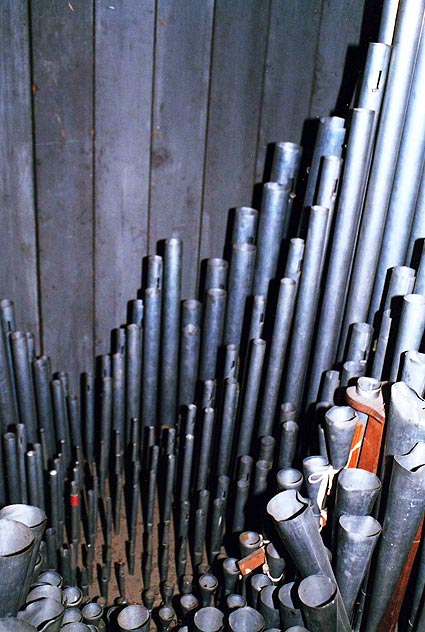 |
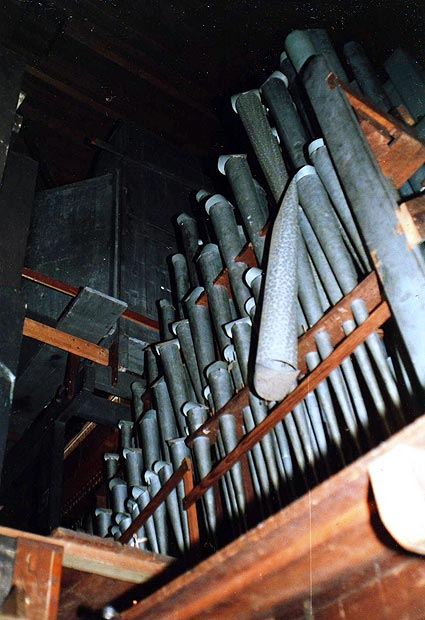 |
|
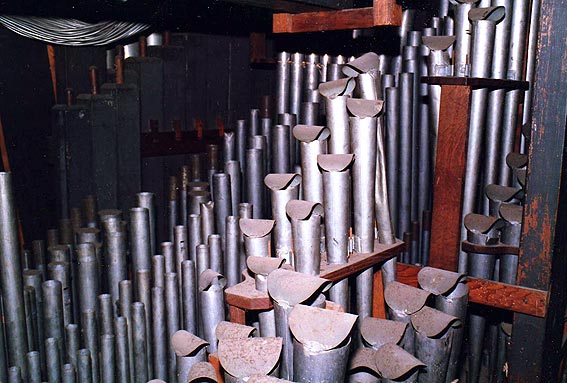 |
||
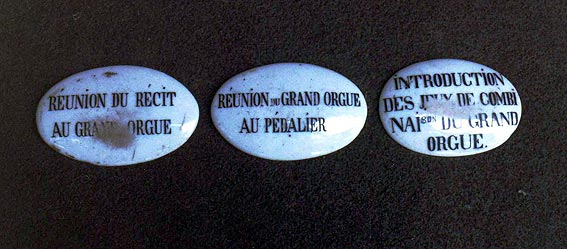 |
||
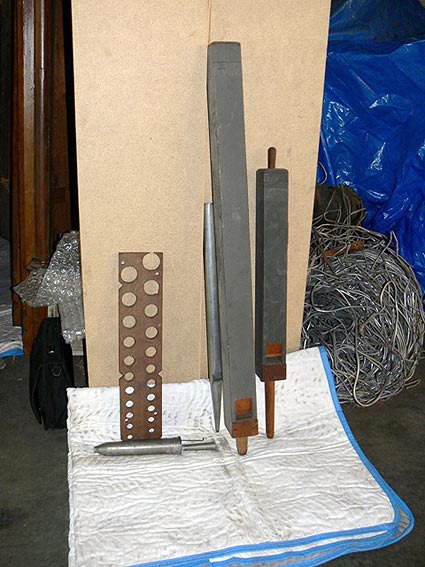 |
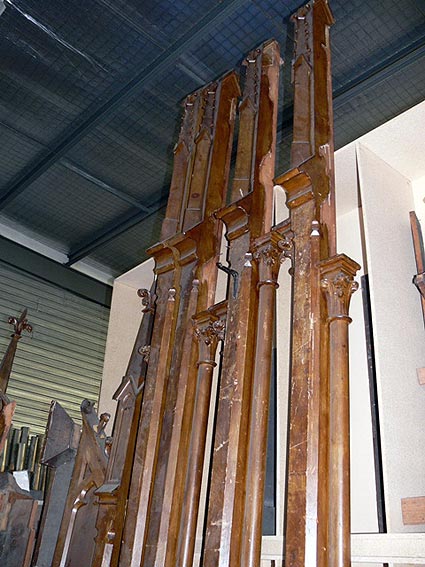 |
|
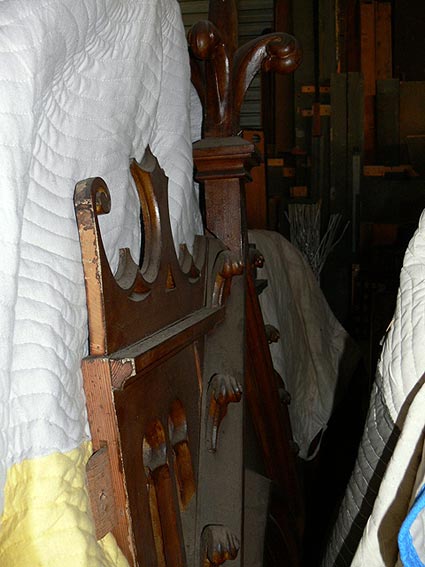 |
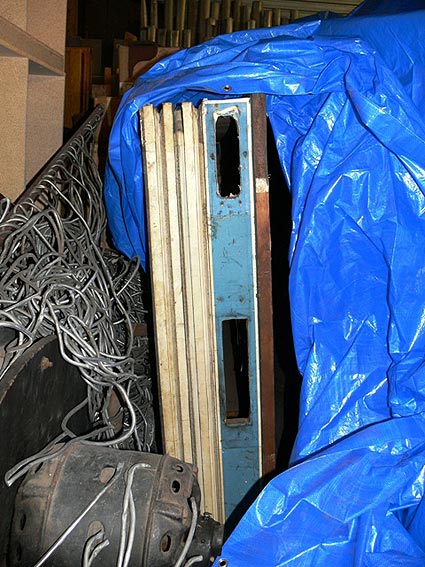 |
|
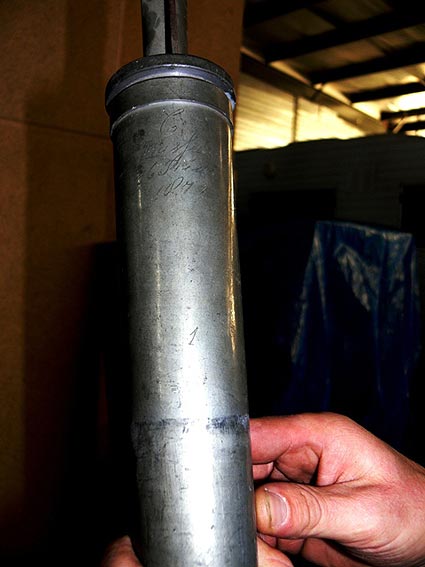 |
||
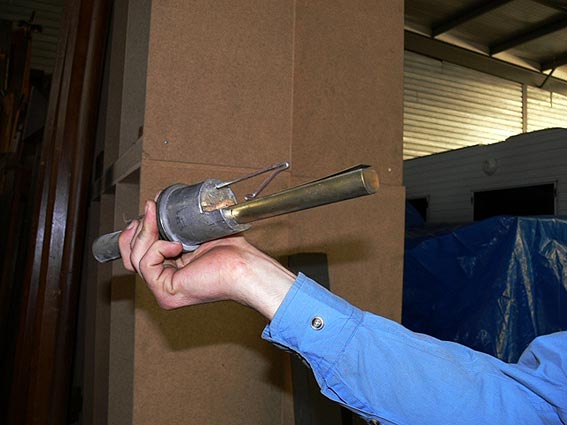 |
||
Photos taken in storage facility.